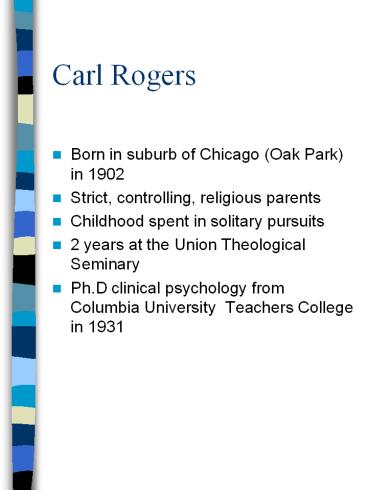Carl Rogers - PowerPoint PPT Presentation
1 / 11
Title:
Carl Rogers
Description:
Lonely. Angry. Fearful. Smart. Manipulative. Compulsive ... Lonely. Honest. Trustworthy. Smart. Moving toward Congruency. Therapeutic Procedures. No Couch ... – PowerPoint PPT presentation
Number of Views:966
Avg rating:3.0/5.0
Title: Carl Rogers
1
Carl Rogers
- Born in suburb of Chicago (Oak Park) in 1902
- Strict, controlling, religious parents
- Childhood spent in solitary pursuits
- 2 years at the Union Theological Seminary
- Ph.D clinical psychology from Columbia University
Teachers College in 1931
2
Rogers Client-Centered TherapyAssumptions
about Human Nature
- Internal Frame of Reference
- Persons behavior - understood from this frame of
reference - Human beings are innately good.
- Need for unconditional positive regard from
others. - Humans are purposive goal-directed.
3
Rogers Client-Centered TherapyAssumptions
about Human Nature
- Core of human life resides in SELF-EXPERIENCE
- Value of life is in PRESENT
- Basic Human Need - Deep Human Relationship
- Internal Rationalities - people do the best
possible thing if conditions are present
4
Development of Personality
- Self-Concept picture or image people have of
themselves. - Self-Experience all that is occurring within
the organism that is potentially available to
awareness. - Ideal-Self the self-concept the person would
like to possess. - Incongruence the difference between the
self-concept and the self-experience. - Actualizing Tendency
- the inherent tendency of the organism to
develop all its capacities in ways that serve to
maintain or enhance the organism.. - (Rogers, 1961)
5
Case Example
Person Smith
Self-Concept How I see me
Self-Experience How I really am
Lonely Angry Fearful Smart Manipulative Compulsive
Joyful Insecure Lonely Honest Trustworthy Smart
Incongruence
6
Psychopathology
- No dividing line between normality and
psychopathology. - Avoid diagnostic labels
- ..such categories as pseudoscientific efforts
to glorify the therapists expertise and depict
the client as a dependent object.. (Rogers,
1951) - Defense responding to experiences that threaten
the self-concept (distortion, denial) - Neurosis Powerful conditions of worth in
self-concept. Incongruent with totality of
experience. - Psychosis Person is badly hurt by life, needs
corrective influence of a deep interpersonal
relationship.
7
Case Example Therapy Begins
Person Smith
Self-Concept How I see me
Self-Experience How I really am
Joyful Insecure Lonely Honest Trustworthy Smart
Lonely Angry Fearful Smart Manipulative Compulsive
Moving toward Congruency
8
Therapeutic Procedures
- No Couch
- No use of interpretation
- No investigation of clients past
- No dream analysis
- Client must perceive three characteristics in the
therapist - Genuine therapist in touch with his/her own
personal experience - Empathic attuned to the clients feelings and
beliefs - Unconditional positive regard Non-judgmental,
non-possessive respect and caring for clients
self-concept and feelings
9
Mechanism of Change
- Abandon the defensive facades that protect
incongruent self-concept. - Accept anxiety-provoking aspects of
self-experience. - Move from incongruence to congruence.
- Establishing a constructive interpersonal
relationship with therapist.
10
Criticisms
- Completely optimist and simplistic view of human
nature. - Three therapeutic conditions are necessary but
insufficient. - Implies therapist must be congruent.
- Diagnosis is also important.
- Avoids confrontation--therapy needs to be
confrontational.
11
Research
- Conducted on three characteristics genuineness,
empathy, and unconditional positive regard. - Some studies found these related to constructive
change in therapy, other studies have found no
relationship (Epstein, 1980) - Self-concept has also been studied. Research
supports notion that therapy is usually related
to increased self-acceptance (Wylie, 1984)

























![[PDF] On Becoming A Person: A Therapist's View of Psychotherapy Kindle PowerPoint PPT Presentation](https://s3.amazonaws.com/images.powershow.com/10084165.th0.jpg?_=20240723087)





